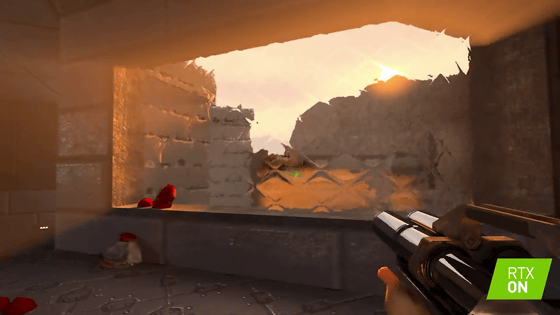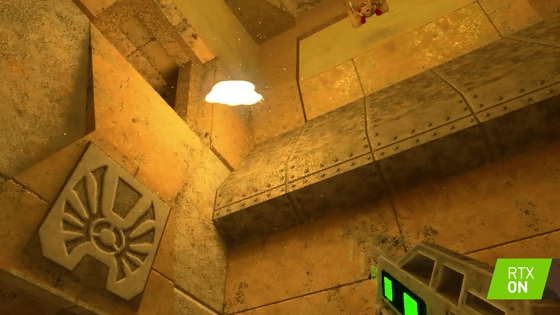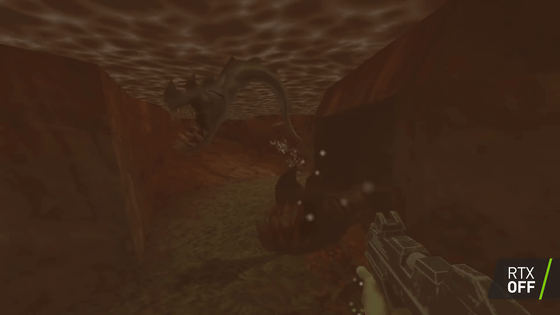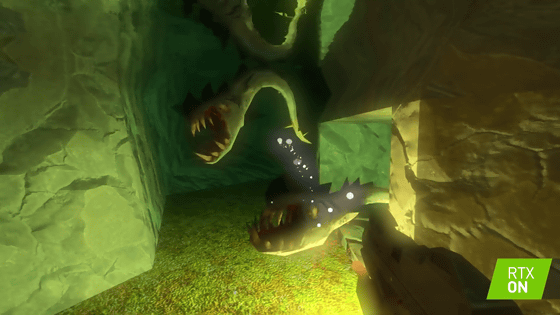NVIDIA explains 'path tracing' that can render beautiful 3D images that are more faithful to reality in games and movies

'The object is visible' in the real world means that 'the light emitted from the light source and reflected by the object is captured by the naked eye or the sensor of the camera'. '
What Is Path Tracing? | NVIDIA Blog
https://blogs.nvidia.com/blog/2022/03/23/what-is-path-tracing/
There are many games and animations that use 3D CG models, but since games and animations are displayed on a 2D flat display, it is necessary to generate 2D image data from the numerical data of the 3D model. .. The process of generating an image from this 3DCG numerical data is called ' rendering '.
NVIDIA first introduced a technology called 'rasterization' that produces images from a single point of view. Rasterization is a technology that converts virtual triangles and polygons that make up 3D data from their size, direction, and color into 2D pixels and draws them. According to NVIDIA, its latest GPU can generate more than 100 billion pixels of image data per second. Rasterization is a good technology for generating game graphics in real time.
And ray tracing is a technology that makes rasterization even more powerful. Rasterization is a technology that converts a 3D model to 2D and draws it, while ray tracing is a technology that draws by tracking the light rays that are transmitted or reflected through the 3D model. Rasterization can only generate images from one point of view, but ray tracing is characterized by being able to generate images from different points of view.According to NVIDIA, 'RTX series GPUs dozens of images per second. It is possible to track hundreds of millions of rays. ' The advantage of ray tracing is that it reproduces the behavior of real light, so it is possible to reproduce in-game the face of a person reflecting on the swaying water surface and the appearance of a passerby reflected on the glass.
According to David Luke, Senior Vice President of Graphics Research at NVIDIA, the history of ray tracing can be traced back to the 16th century.
Albrecht Dürer , one of the leading painters of the Scandinavian Renaissance, wrote in 1538, 'Treatise on Measurement,' because 'we are looking at the light.' We are presenting ideas for capturing and grasping the trajectory of light using thread.

And in 1969, more than 400 years after Durer's death, IBM's Arthur Appel brought the concept of ray tracing into the world of computer graphics (CG), an idea to calculate the appearance and shadow of things from the orbit of light. Invented. Ten years later, in 1979, Turner Whited, a researcher at

The film industry was one of the first to adopt this ray tracing technology.

This rendering equation is not that complicated. However, it is not uncommon for a CG model to be composed of billions of triangles and polygons, so it is not practical to solve all the equations. Therefore, Lucasfilm proposed a rendering method 'path tracing' that statistically finds the solution of the rendering equation using the
When light hits a transparent glass, some light passes through the glass, while the rest of the light is reflected off the surface of the glass, so ray tracing is reflected when the 3D model is exposed to light. The case is branched and processed. Path tracing, on the other hand, traces a single ray as a single ray without branching between transmission and reflection, and processes whether it is transmitted or reflected with probability.
Path tracing was considered 'the most elegant and accurate rendering technique', but it wasn't practical at the time of its announcement. In a paper published by the Lucasfilm team, an image of 256 x 256 pixels was rendered, but at that time it took more than 7 hours to render even with a fairly high-performance computer.
However, with advances in semiconductor technology, the computing power of microprocessors has improved exponentially according to Moore's Law, making past racing a sufficiently practical technology. The CG animation movie ' Monster House ' released in 2006 is the world's first full-length rendered movie by path tracing, and was co-developed by Sony Pictures Imageworks and Solid Angle SL, which was later acquired by Autodesk . The renderer ' Arnold ' was used.
Unlike movies, where the video rendered on an ultra-high performance machine is finally edited and released as a complete package , the game needs to be rendered in real time on a machine with limited performance. As a result, real-time rendering with ray tracing has only been used in games relatively recently, with only partial adoption of ray tracing in addition to traditional rasterization-based rendering technology. Real-time rendering with path tracing was considered unrealizable.
However, NVIDIA said, 'With GPUs becoming faster and machines equipped with the RTX series becoming more widespread, real-time path tracing is imminent.' In fact, in 2019, NVIDIA released a remastered video of the 1997 game Quake II rendered with path tracing.
Remastering 1997's Quake II with Ray Tracing --YouTube
The scenery through the glass is distorted by refraction, and the setting sun is scattered in the air.

The place where the light hits and the shadow are never clearly separated, and the boundary is reproduced where it is slightly blurred due to the scattering of light.

If you turn off all ray tracing including path tracing and render with rasterization, it looks like this.

The following is a rendering of the same scene with path tracing. As the GPU evolves to enable real-time path tracing, it can be expected that the video expression of the game will become even more beautiful.

Related Posts:







